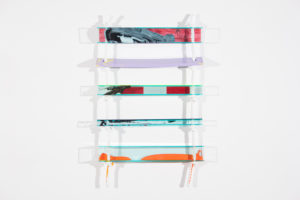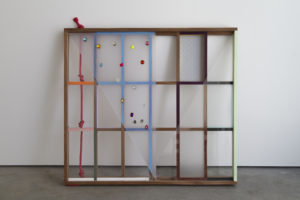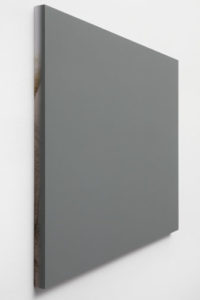July 3, 2014—August 16, 2014 | Reception Thursday, July 3rd, 6-8 pm
James Harris Gallery is pleased to present a show titled Tectonic Dynamics and will include the works by Evan Nesbit, Gibran Mevlana, and Brandon Lattu. The exhibition explores the ideas of change in structural and formal constructs of painting, photography and sculpture through the use and application of specific materials. By combining diverse components or using traditional mediums in an unconventional way, the artist’s hope to challenge viewership and critique pictorial space.
All of the work selected for the exhibition is fundamentally linked to light and how observation is mediated by it. Light is absorbed or reflected by surfaces and artists often apply and choose specific materials to give the viewer a means to question their own perception, knowledge and experience. Illusion is something that all three artists in this show work with to investigate the formal constructs of an artwork.
Gibran Mevlana uses wood, Plexiglas, paint, rope and plastic to create free standing and wall mounted sculpture. These diverse materials are employed by the artist not only for formal relationships but also used to activate surface and challenge the visual weight of an object. Her unique combination of materials destabilizes how the viewer perceives each work as they experience it. “After Dark,” a free standing work is fabricated from wood and acrylic plastic; the surfaces painted, punctuated with laser cut holes or applied with photographic reproduction. The sculpture’s verticality is interrupted by skewed geometric forms where translucency contradicts solidity. The visual weight of the work changes as the viewer experiences the piece.
Painting is pushed optically through the combination of acrylic paints and dye on brown burlap in Evan Nesbit’s work. Physically, Nesbit does something quite interesting in the way he plays with paint as is protrudes through and soaks into the burlap. At times, the paint comes out into the viewer’s space physically and forms a sculptural layer on the surface. It is three-dimensional and enticing, the closer one gets to the wall. The results provoke the viewer to engage in an active participatory role, as the gaze conflates the static physicality of the canvas with the natural saccadic movement of vision. Highly influenced by phenomenological philosopher, Maurice Merleau-Ponty; Nesbit harnesses philosophical investigations of human perception to address issues within image making in an effort to not only exist as an object, or momentous glance, but as an invitation for a suspended visceral exchange.
Brandon Lattu’s photographic process expands beyond the traditional two dimensional constructs of a photograph. In the series “Random Composition,” the artist creates a three dimensional object with four different photographs that occupy the sides, top, and bottom. The face is composed of a plane of monochromatic color. At first glance they present a minimalist color block to the viewer but it’s surrounded by photographs that connect to the wall. The viewer observes a pictorial shift from the illusion of space captured by the camera yet interrupted by the solid color. The objects are generated randomly: the dimensions of the piece, the color of the front, and the selection of images from an archive of almost 100,000 photographs. Lattu does not subjectively compose them, but after they exist virtually as ready-mades constructed with this system, he fabricates ones that are chosen in a fashion that relates to the kind of selection process that a photographer has traditionally made while looking at a contact sheet.
Tectonic Dynamics is an optical investigation of spatial perception by three artists, each demonstrating structural shifts through visual clues, All three artists currently work and live in California. Evan Nesbit is a graduate of Yale University and has recently exhibited at Roberts & Tilton. Gibran Mevlana recently graduated from Art Center and this exhibition marks her first at a gallery. Brandon Lattu teaches photography at University of California Riverside and currently has work in a group exhibition at the Metropolitan Museum of Art. He shows with Koenig and Clinton in New York and has exhibited internationally.
Evan Nesbit
Evan Nesbit's primary focus iss spatial abstraction where his burlap canvases were meticulously crafted through a process of dying, sewing and extrusion of acrylic paint pressed through the weave of the material. By dying the support structure and driving the pigment medium through it, the artist seamlessly integrated the medium with the support, creating an aesthetic teleology of flatness and pictorial organization. Nesbit continues his use of pushing pigment through the reverse side of the substrate, and now photographic images have been introduced by printing on a vinyl matrix. His markings compliment and disrupt the physical traces of reproduced photograph, trapping the image between the mechanical and the painted gesture. Nesbit’s new paintings allude to the inevitable commodification of the digital image but through his use of highly saturated color and neon tones of paint, the works situate themselves between the historical and contemporary painting antecedents in which artists incorporated found or mechanically produced images.
Evan Nesbit (b. 1985) lives and works in Grass Valley, CA. Nesbit received his BFA from San Francisco Art Institute in 2009 and his MFA from Yale University in 2012. He has been awarded the Yale University Ely Harwood Schless Memorial Fund Prize for painting. Other recent solo exhibitions include: Van Doren Waxter, New York, Annarumma Gallery, Naples, Italy (2017); Koki Arts, Tokyo, Japan, Roberts and Tilton, Los Angeles, CA, 11R, New York, NY(2016. His work has additionally been included in numerous group exhibitions, such as: Sargent’s Daughter, New York NY (2017) 88 Projects Berlin, Germany Praz-Delavallade, Paris, France (2015).
Acrylic plastic, walnut wood, birch wood, acrylic paint, giclee print
70" x 24" x 12"
Inquire about this work
Acrylic plastic, vinyl, fabric, nylon rope, acrylic paint
46" x 27" x 4"
Inquire about this work
African Mahogany wood, metal sheeting, acrylic plastic, nylon rope, acrylic paint
41 1/2" x 46" x 4"
Inquire about this work
Pigment on polypropylene, wood and polystyrene
21" x 26" x 1"
Inquire about this work
Pigment on polypropylene, wood and polystyrene
27" x 26" x 9"
Inquire about this work
Pigment on polypropylene, wood and polystyrene
24" x 9" x 16"
Inquire about this work
Acrylic, dye, and burlap
32" x 26"
Private Collection
Acrylic and burlaps
42" x 36"
Private Collection
Acrylic, dye and burlaps
42" x 36"
Private Collection









